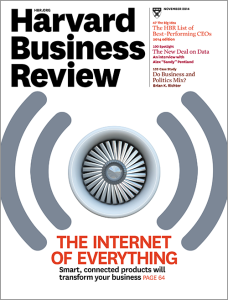Twice before in the last 50 years, Information Technology (IT) “radically reshaped competition and strategy” and once again, the world finds itself on the brink of a third transformation.
 The first IT wave was during the 1960s and 1970s, while the rise of the Internet in the 1980s was the second. Now, in the third wave, IT was becoming an integral part of the product itself. The phrase “Internet of Things” (IoT) had come about to reflect the growing number of smart, connected products, and highlight the new opportunities they represent.
The first IT wave was during the 1960s and 1970s, while the rise of the Internet in the 1980s was the second. Now, in the third wave, IT was becoming an integral part of the product itself. The phrase “Internet of Things” (IoT) had come about to reflect the growing number of smart, connected products, and highlight the new opportunities they represent.
“Yet this phrase is not very helpful in understanding the phenomenon or its implications,” argue Michael Porter, an economist with the Harvard Business School and James Heppelmann, President and Chief Executive Officer of PTC, in a November Harvard Business Review essay.
PTC, incidentally, is a product design software firm that recently acquired machine-to-machine (M2M) firm Axeda Corp.
Before the advent of modern information technology, say the two authors, products were mechanical and activities in the value chain were performed using manual, paper processes and verbal communication. It was with the advent of the Internet, with its inexpensive and ubiquitous connectivity, that the second wave of IT-driven transformation was sparked off. This had enabled coordination and integration across individual activities; with outside suppliers, channels, and customers; and across geography. It allowed firms, for example, to closely integrate globally distributed supply chains.
The first two waves gave rise to huge productivity gains and growth across the economy. While the value chain was transformed, however, products themselves were largely unaffected. That was the differentiator between those two and the third wave.
Today, say the two writers, embedded sensors, processors, software, and connectivity in products, coupled with a product Cloud in which product data is stored and analysed and some applications are run, are driving dramatic improvements in product functionality and performance. Massive amounts of new product-usage data enable many of those improvements.
Such smart, connected products raise a new set of strategic choices related to how value is created and captured, how the prodigious amount of new data they generate is utilised and managed, how relationships with traditional business partners such as channels are redefined, and what role companies should play as industry boundaries are expanded.
The phrase, IoT, though, is not adequate to understand the phenomenon or its implications. The Internet, point out the authors of the Harvard paper, whether involving people or things, is simply a mechanism for transmitting information. What makes smart, connected products fundamentally different is not the Web, but “the changing nature of the “things.” It is the expanded capabilities of smart, connected products and the data they generate that are ushering in a new era of competition.
Both have said companies should now look beyond the technologies themselves to the competitive transformation taking place. That’s also because it was almost about time that a leap in productivity in the economy to be be unleashed by new and better products. In addition, producing them will reshape the value chain yet again, by changing product design, marketing, manufacturing, and after-sale service and by creating the need for new activities such as product data analytics and security. This will drive yet another wave of value-chain-based productivity improvement. The third wave of IT-driven transformation thus has the potential to be the biggest yet, triggering even more innovation, productivity gains, and economic growth than the previous two.
The authors have said some people have suggested that the IoT “changes everything,” but that is a dangerous oversimplification. As with the Internet itself, smart, connected products reflect a whole new set of technological possibilities that have emerged. But the rules of competition and competitive advantage remain the same. Navigating the world of smart, connected products requires that companies understand these rules better than ever.
Image Credit: Harvard Business Review
– Advertising Message –
